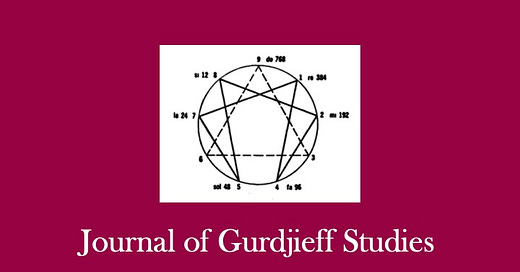Part 1 – Reading, Language, Understanding and Attention
This is a list of contents of articles in Part 1, with handy summaries and links, for ease of orientation and navigation. These, together with Part 2, are also the contents of the newly published Volume I of Journal of Gurdjieff Studies, which has extensively rewritten articles:
See also:
Please note that articles assume familiarity with fundamental fourth way texts. See Introduction and Bibliography for guidance.
See also:
L’Inhumaine – A Preparation for Meeting Gurdjieff – Human or inhuman? An interpretation of an unusual and striking film, suggesting that the one who was the driving force behind the film, namely, Georgette Leblanc, was ripe and thirsting for the encounter with Gurdjieff which was to change her life.
Part 1 – Reading, Language, Understanding and Attention
This part includes, among other things, the challenges and possibilities of reading, exploration of why language is so important on the path to understanding, What is understanding and what does it do? How may we gain attention? There is also material on thinking, memory, sensing, identification, and meaning, and a first look at the cerebellum and the “fish” diagram, which is explored further in later posts.
1.1 – How to Read? – A moment of “fast”; maintaining a state of intellectual health; knowing “when to feed”; change of tempo.
1.2 – The Results the Reader Ought to Have – Active pursuit and automatic assimilation; right order; listening; conscious mentation.
1.3 – Read Again – Inner change; fragmentary nature of sources, including Gurdjieff’s writings; context of transcribed records; what is the “third series”?
1.4 – Cheap Inspiration Versus Creative Thinking – The necessity of thinking as well as being; peculiar contemplation; the “onanism” of one-sided development; what is the best state for thinking?; “inspiration is cheap”; confrontation and criticism; a hypnotic flow or the possibility of something else; to “keep oneself”; emptying the mind except for one thing; building helpful associations; the pact between “I think” and “it thinks.”
1.5 – Piquant Sources and Other Flavours - Section 1; Section 2 – Is it important to know the source? And where and what is the source anyway? What to believe? How should one evaluate apparent secondary sources, specifically considering Ouspensky’s “Fragments”?
1.6 – Perception of the Sense of Gurdjieff’s Words – How good or bad was Gurdjieff’s English and French really? Philology as a route to Truth; relativity; roots and context; beware of taking conventional meanings.
1.7 – Exact and Inexact – The principle of relativity and possible evolution; two kinds of mentation; inexactitudes, also lawful; the law of seven and the fractioning of phenomena; fragments and making paste; approaching truth in the form of a lie; enabling digestion.
1.8 – A New Principle of Language – The triad of knowledge, being and understanding; why is exact language important for understanding, in this sense?; making an impossible idea practical.
1.9 – Projection Towards an Ideal – A taste of a state of normality
1.10 – Ideas and Understanding: The First Remedy for Abnormality – Examination of understanding to increase understanding; the law of three and the arising of phenomena
1.11 – Language, Understanding and Medicine – Confrontation, contact and blending of functionings; the essence of certain real notions passing from the “waking consciousness” to the subconsciousness; randomness or the proper sequence; the corrective remedy of practical life; willingly increasing the polarity; recognition of nothingness enabling possibility of contact; correspondence, opposition and regulation on the path to understanding; medicine for the psyche.
1.12 – All Life is a Stage – Playing a role helps work against identification; can one even play a role when alone?; connection with commanding the body.
1.13 – The Greatest force – Accessing force from new ideas; becoming free from associations; standing before the unknown.
1.14 – The possession of truth – The Harnelmiatznel of being and knowledge; are Orage and Ouspensky transmitting the same thing from Gurdjieff?; seeming contradictions again; being responsible?
1.15 – Transubstantiation for One's Presence – The seed in the bud; not enough will for what is understood; understanding can also be suffering; functions of the three higher centres; consciousness of the heart; understanding as an integration between Centres #4 and #5; self-calming inhibiting sincere thinking; what is the difference between the three Hydrogen 48’s?; to have experience in order to understand.
1.16 – Empty or Full Knowledge? – Knowledge and being compared with personality and essence; “individuality, can grow only from . . . essence”; the doing of seeing?; the magnetic tie between ourselves as we are and as we should be; the need for both love and hatred.
1.17 – Combining and Separating – The use of working with seeming discrepancies; to mix or not to mix.
1.18 – Thinking in a New Way – Thinking versus automatic association; knowing what to think about; influences from higher centres.
1.19 – The Science of Action with Non-identifying – “It must not be changed”; lifting the curtain; reclaiming the “I”; “the very touchstone of the whole matter.”
1.20 – Wrapping Up and Muffling, or Opening and Resounding – What actually are words and their function? The formatory apparatus among various confusions.
1.21 – Why Don’t Things Add Up? – Exact formulation preserved; yet we must think for ourselves about and from the ideas; building a new set of associations; a process of friction and fire; the basis for free thought; a capsule of castor oil for mental constipation.
1.22 – The Cushioning of Reality – Contradictions again – this time in oneself. How to see them? Trying to put things into one’s own words and finding illustrative examples.
1.23 – Unbuffering and Understanding – Self-initiation through science studies; a problem with perception; the question of regaining our birthright of the shock of new impressions; buffers preventing self-remembering; impressions losing force; only “I” can fill the fourth centre; what is corresponding data?; the third factor in the formation of the three totalities of psychic functioning and the striving for selfhood at different levels.
1.24 – Keeping the Work Warm – Keeping the pot boiling; saving energy; producing Mi 12; incubating meaning eggs.
1.25 – The Pairing of Sensing – “Sensing and perceiving” and a number of equivalent pairings, including observation and constatation; picturing outgoing and incoming “currents” of attention;
1.26 – SURE-ing – The need for faith and the need for no faith; the critical mind; faith transmuted from understanding;
1.27 – Thoughts on “Memory working together with sense makes attention” – Practical significance; “must have attention. What is attention?”; differently sourced associations and present perceptions (and something else) working together; the functioning of associations; attention as a factor in the prolongation of life.
1.28 – The Cerebellum or Centre #4 – Horns; the cerebellum in the “fish” diagram; the back of the brain; link with hypnosis; the proper relationship of the front and back parts of the head brain cf personality and essence; equivalence with the higher intellectual centre, individuality, I, essence; waste from impressions accumulating in the cerebellum; air, thinking and inner vision; at present largely non-functional.






